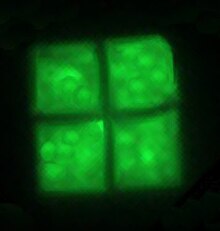Haloquadratum
| Haloquadratum | |
|---|---|
 |
|
| Scientific classification | |
| Domain: | Archaea |
| Kingdom: | Euryarchaeota |
| Phylum: | Euryarchaeota |
| Class: | Halobacteria |
| Order: | Halobacteriales |
| Family: | Halobacteriaceae |
| Genus: |
Haloquadratum Burns et al. 2007 |
| Species | |
Haloquadratum is a halophilic genus of the family Halobacteriaceae. The first species to be identified in this group, Haloquadratum walsbyi, is unusual in that its cells are shaped like flat, square boxes.
Discovered in 1980 by A.E. Walsby in the Gavish Sabkha, a coastal brine pool on the Sinai Peninsula in Egypt, the archaean was not cultured until 2004.
The cells typically contain polyhydroxyalkanoate (PHA) granules, as well as large numbers of refractile, gas-filled vacuoles which provide buoyancy in a watery environment and may help to position the cells to maximise light-harvesting. The cells may join with others to form fragile sheets up to 40 micrometres wide.
H. walsbyi can be found anywhere in hypersaline waters. When sea water evaporates, high concentration and precipitation of calcium carbonate and calcium sulphate result, leading to a hypersaline sodium chloride-rich brine. Further evaporation results in the precipitation of sodium chloride or halite, and then to a concentrated magnesium chloride brine termed bittern. During the final stage of halite formation, before magnesium chloride concentration causes the brine to become sterile, H. walsbyi flourishes and can make up 80% of the brine's biomass.
H. walsbyi was first discovered in 1980 by A.E. Walsby in the Gavish Sabkha, a coastal brine pool in the Sinai peninsula, Egypt, and formally described by Burns et al. in 2007. The organisms were notable because of their extremely thin (around 0.15 μm), square-shaped structure. It was not cultivated in the lab until 2004.
The mapping of H. walsbyi's genome has been completed, giving a better understanding of the organism's genealogy and taxonomy, and the role it plays in the ecosystem. A genomic comparison of the Spanish and Australian isolates (strains HBSQ001 and C23T) strongly suggests a rapid global dispersion, as they are so similar and have retained gene order (synteny).
...
Wikipedia
